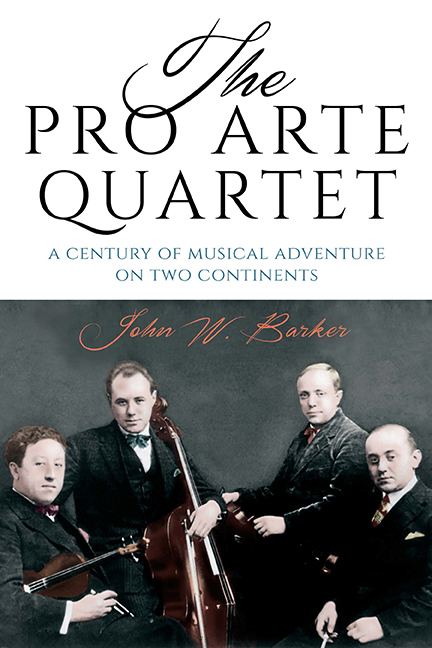Book contents
- Frontmatter
- Dedication
- Contents
- Preface
- Lists of Quartet Membership
- Introduction: Quartet Contexts
- 1 The Onnou Years, I (1912–31)
- 2 The Onnou Years, II (1932–40)
- 3 The Brosa Years (1940–44)
- 4 The Kolisch Years (1944–67)
- 5 The Paulu Years, I (1967–79)
- 6 The Paulu Years, II (1979–95)
- 7 The Perry Years (1995–Present)
- Conclusion: Retrospect and Prospects
- Appendixes
- Selected Bibliography
- Index A Composers
- Index B General
A - Benny Goodman and the QPA
Published online by Cambridge University Press: 10 June 2021
- Frontmatter
- Dedication
- Contents
- Preface
- Lists of Quartet Membership
- Introduction: Quartet Contexts
- 1 The Onnou Years, I (1912–31)
- 2 The Onnou Years, II (1932–40)
- 3 The Brosa Years (1940–44)
- 4 The Kolisch Years (1944–67)
- 5 The Paulu Years, I (1967–79)
- 6 The Paulu Years, II (1979–95)
- 7 The Perry Years (1995–Present)
- Conclusion: Retrospect and Prospects
- Appendixes
- Selected Bibliography
- Index A Composers
- Index B General
Summary
One great and rather bizarre mystery haunts the Pro Arte's recording history—that of Mozart's Clarinet Quintet K. 581, and its association with Benny Goodman. During the 1930s, that great jazz musician was developing an interest in classical music literature, with the Mozart Quintet as his first target. For their part, the Pro Arte performed the work a reported eight times over the years, at least twice with the distinguished clarinetist Louis Cahuzac.
The performance catalogue compiled by Anne Van Malderen asserts that the quartet played it twice in public with Goodman: first on July 10, 1935, at Mills College, and then on February 12, 1938. Those reports are apparently incorrect, for there is no evidence that the Pro Arte ever played the work with Goodman in public performance. But Van Malderen also reports that Goodman and the Pro Arte made an incomplete recording of it with Goodman in “early 1936,” at the Abbey Road studios in London (pp. 486–87).
Now, it is clear from Van Malderen's own performance registry that such a dating is of insecure credibility. In January 1936 the Pro Arte was involved in “overlapping” Beethoven Quartet cycles in Belgium. To be sure, the quartet was in the London area in February 1936, and in one concert played this Mozart Quintet, if not with Goodman as soloist.
The literature on Goodman, however, offers conflicting information. There are no references to Goodman ever playing with the Pro Arte in public; the Van Malderen reports of such on two occasions may be regarded as quite dubious. As to the ill-fated recording session, we are given a very different picture.
According to the jazz recording producer and critic John Hammond— also violist of the Coolidge Quartet—he himself urged Goodman to investigate classical literature. (Hammond thought it would be healthy to build bridges between jazz and classical music making, an idea he later concluded was a mistake.) Goodman knew virtually nothing of classical music, and had never heard—or heard of—the Mozart Clarinet Quintet, which Hammond suggested for a start. Around the spring of 1935, Hammond pulled together three other New York string players (himself on viola), and for three weeks, once a week, they rehearsed the quintet with Goodman.
- Type
- Chapter
- Information
- The Pro Arte QuartetA Century of Musical Adventure on Two Continents, pp. 249 - 252Publisher: Boydell & BrewerPrint publication year: 2017



